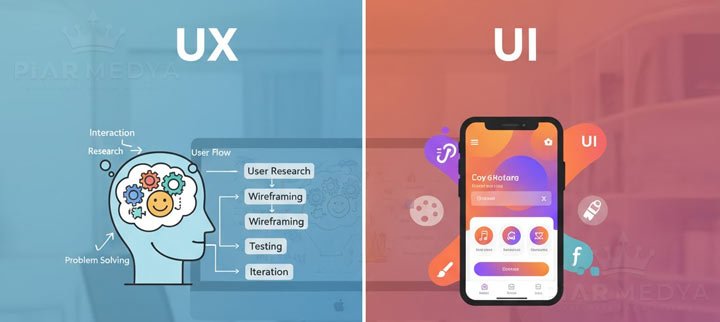What is the Difference Between User Experience (UX) and User Interface (UI)? Their Critical Roles in Web Design
What is the difference between UX and UI? Learn how these two critical web design concepts (User Experience and User Interface) affect your site's success. You will find answers to all your questions related to topic What is the Difference Between User Experience (UX) and User Interface (UI)? Their Critical Roles in Web Design in the continuation of the text.

The Difference Between User Experience (UX) and User Interface (UI): The Secret to a Successful Website
What is User Experience (UX) Design? (The Skeleton and Strategy)
What is User Interface (UI) Design? (The Paint and Furniture)
What is the Core Difference Between UX and UI? (The Clearest Comparison)
The Critical Role of Web Design: Why Must UI and UX Work Together?
Conclusion: Not Just "Beautiful," but "Smart" Design
When you step into the world of web design, two terms constantly appear: UX (User Experience) and UI (User Interface). Although these two concepts are often used interchangeably, they are actually two critical, complementary, yet fundamentally different disciplines that determine the success of a website. Many businesses want a website that "looks good"; however, what they really need is a website that "produces results." The path to producing results passes through the perfect harmony of these two concepts.
The Difference Between User Experience (UX) and User Interface (UI): The Secret to a Successful Website
What is the clear difference between the UX that increases a site's conversion rate and the UI that reflects your brand's identity? As Piar Medya, with the vision of an agency that not only writes code but also understands the user and develops strategy, we are illuminating these two vital concepts for you. Understanding the cornerstones of creating a successful digital presence also determines the quality of service you will receive from a professional web design agency.
What is User Experience (UX) Design? (The Skeleton and Strategy)
User Experience (UX) Design refers to the entire journey a user takes when interacting with your product or website. UX focuses on the "Why?" and "How?" questions. Its primary goal is to enable the user to reach their objective in the easiest, most logical, and most enjoyable way possible.
You can think of UX as the architectural plan of a house. The architect thinks about how you will live in the home: "What is the easiest way to reach the kitchen? How can the living room's light be used most efficiently? Is the flow between rooms smooth?" In the same way, the UX designer plans the user's journey on the site:
- Can the user easily find the "contact" information when they look for it?
- How many steps does the purchasing process consist of? Are there unnecessary steps?
- Is navigating on a mobile device as easy as on a desktop? (See: What is Responsive Design?)
- Is the site's information architecture logical?
The core components of UX are user research, persona creation, information architecture, and "wireframe" drawings. A good UX design reduces your site's bounce rate, increases the time spent on site, and most importantly, directly boosts the conversion rate of your visitors into customers.
What is User Interface (UI) Design? (The Paint and Furniture)
User Interface (UI) Design is concerned with "how" that architectural plan drawn by UX "looks." UI is not the journey itself, but the aesthetic and visual features of the vehicle used during the journey. It focuses entirely on the "What?" question—that is, the appearance.
Returning to the house metaphor, UI is the color of that house's walls, the style of the furniture, the lighting used, and the design of the doorknobs. The goal of the UI designer is to give the functional skeleton determined by UX an aesthetic, attractive appearance that is consistent with your brand identity and enjoyable to use.
The core components of UI are visual design, color palettes, typography, buttons, icons, form elements, and the general layout. A good UI design reflects your brand's professionalism, inspires trust in the user, and allows them to form an emotional bond with your site. We previously discussed in detail how good web design strengthens brand perception.
What is the Core Difference Between UX and UI? (The Clearest Comparison)
The easiest way to separate the two concepts is this: UX deals with functionality and feeling, while UI deals with appearance and aesthetics.
There is a great restaurant metaphor:
- UX (The Experience): Easily finding the restaurant's location, the simplicity of making a reservation, the way you are greeted at the door, the menu's clarity, the order arriving correctly, and the waiter's attitude toward you. In short, it is the overall satisfaction you feel when you leave the restaurant.
- UI (The Interface): The restaurant's decor, the elegance of the tables, the comfort of the chairs, the design of the plates, and how beautiful the menu's cover and the text inside it look.
If the menu is very stylish (good UI) but the dish names are incomprehensible (bad UX), you can't order. Or if the ordering process is very easy (good UX) but the restaurant looks dirty and tasteless (bad UI), you won't want to sit there.
In short:
- UX helps the user solve a problem.
- UI determines what the solution looks like.
- UX is the left side of the brain (analytical, logical).
- UI is the right side of the brain (creative, aesthetic).
The Critical Role of Web Design: Why Must UI and UX Work Together?
In modern web design, it is impossible to separate these two concepts. The failure of one nullifies the entire effort of the other.
- Bad UX + Good UI: A website that looks fantastic, is aesthetically perfect, but is very complicated to use. Users will leave your site because they can't find what they're looking for.
- Good UX + Bad UI: A website that is very easy to use, with fluid menus, but looks like it's from the 90s, is tasteless, and amateurish. Users will leave again, thinking your site is not trustworthy.
A successful website combines these two forces. As Piar Medya, our web design approach is to first build the UX strategy by asking "what does the user want?" and then to dress it with an aesthetic UI by asking "who is your brand?". This user-centric approach is also directly related to Google's experience-focused ranking factors like Core Web Vitals and positively impacts your SEO performance as well.
Conclusion: Not Just "Beautiful," but "Smart" Design
User Experience (UX) is the foundation of a website; it is the invisible but vital skeleton. User Interface (UI) is the visual identity built upon that foundation, reflecting your brand's character and making first contact with the user.
On your next web project, demand not just a design that "looks good," but a "smart and user-centric" design that allows you to reach your goals. Get a quote from Piar Medya's expert team to build your business's digital face with a flawless experience, both aesthetically and functionally.






